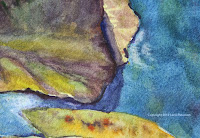Watercolor
Project: Water Lily Week 4
Torrance
class the information regarding the negative painting of the flower petals is
near the end of last week’s blog because I started the process at PV the
previous week, so look there for reference.
Theyellow center area is probably the trickiest because there is a combination of
grayish shadows on some of it and a reddish orange on the rest, this is where
really looking at the photo is going to be important because I simply cannot do
more than give you general areas here, please have you photos out and look at
them often BEFORE you start this process.
The
gray color is going to be yellow with a touch of purple and a lot of water. It
should look gray and not purple and on a value scale of 1 – 10, 1 being white,
this should be no more than a 2. This color goes on the yellow stamens/pistils
that are in the back also there is a bit in the center and along the front
behind the petal. The orange color is orange with a touch of red and it goes in
between some of the front structures. Be sure to check the angles and shapes
before you start putting on color. There are also some dark parts that seem to
be on the sides of some of these structures, I just took my small angle brush
and put some dark color from my palette and just touched the full edge of the
brush to form a line. When in doubt, practice it first.
 There
are a couple of the petals that have some green stripes on them, this is very
easy if you slightly wet the petal first – you want it damp not dripping – and
either with a liner or the edges of a flat/angle brush, draw the lines in with
sap green but be sure you follow the couture of the petal, they are not flat,
they are curved. As the green mingles with the dampness of the paper it will
slightly fuss out, if it disappears altogether, your paper was too wet, if it
doesn’t fuzz out at all your paper was too dry. Again practice it first. This
is the same thing I did to add the pink tips to some of the petals, I wet the
tip and down a bit on the petal the just put color at the tip and let it spread
down through the damp paper, guiding it sometimes with a damp brush with just
water.
There
are a couple of the petals that have some green stripes on them, this is very
easy if you slightly wet the petal first – you want it damp not dripping – and
either with a liner or the edges of a flat/angle brush, draw the lines in with
sap green but be sure you follow the couture of the petal, they are not flat,
they are curved. As the green mingles with the dampness of the paper it will
slightly fuss out, if it disappears altogether, your paper was too wet, if it
doesn’t fuzz out at all your paper was too dry. Again practice it first. This
is the same thing I did to add the pink tips to some of the petals, I wet the
tip and down a bit on the petal the just put color at the tip and let it spread
down through the damp paper, guiding it sometimes with a damp brush with just
water.
(From
here on is what we did different at PV and what we will be doing at Torrance
next class.)
The
petal that goes under water also has a bit of a shadow falling across the
middle of it but the lower part is going to need a light wash of blue. If you
have a blue on the mixing part of your palette just add some water and lightly
go over the bottom of the petal or use a tiny amount of a color similar to you
water, you just want to tint the petal. If you did what I did at PV and painted
too heavy over the petal and need to lift some color off to shape the petal
that is under the water, just use the color you are lifting in one area and
tint the other area with what is on your brush.
The
shadows under the flower are very dark but you can see a bit of detail in them.
Do not worry about that detail at this point it will look better if you go in
later and lift out a bit of color than to worry about it as you are trying to
paint the shadow in.
I
started my shadows with just a mix of blue and purple, keeping it on the blue
side. To be honest, once I got it home and could see it in better light, I am
not completely happy with it so I will be tweaking it in our next class. I
think I need some green and some sienna to gray up the color a bit and I do
need it darker right under the flower, it isn’t dark enough.
I
free-handed my shadow, if you need to draw it in that is okay too but when you
are lifting out detail also take a damp brush and go across the edges of the
shadow horizontally to soften the edges just a bit, then finish up anything you
may have missed.
The
PV class should be done with this project and students should be bringing in
something that they want to paint for class. Torrance students we will probably
finish up the project at our next class and you might want to start looking for
your own projects as well. I will see you all in class.












